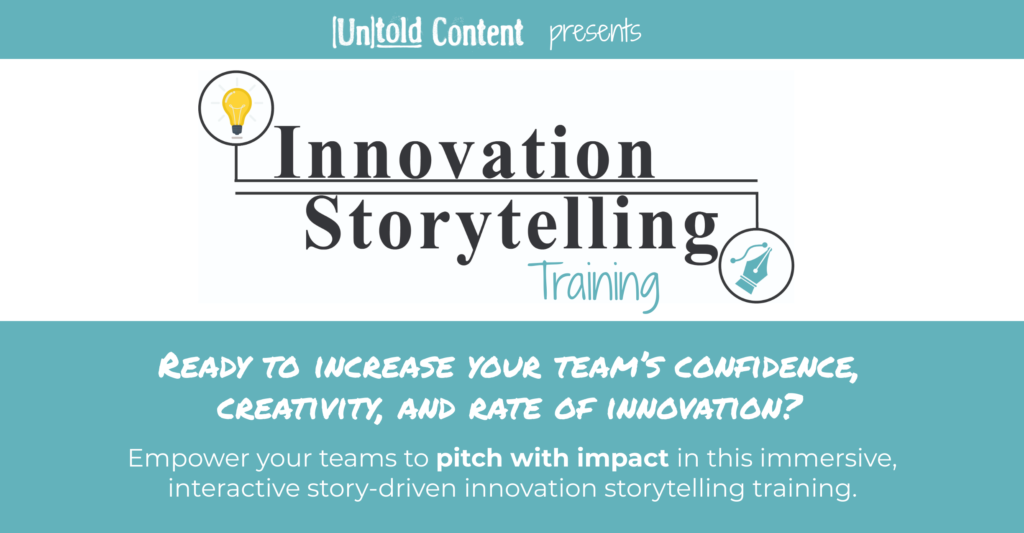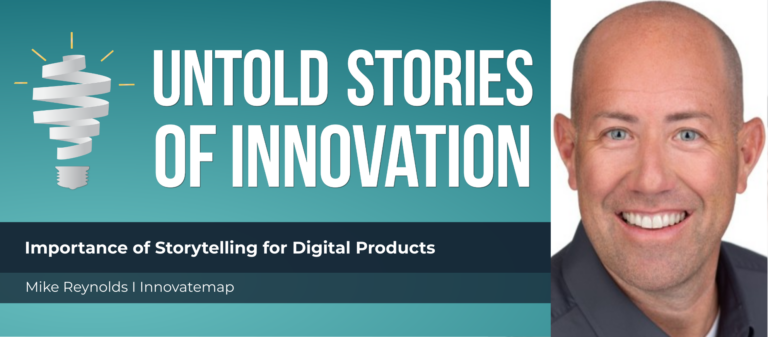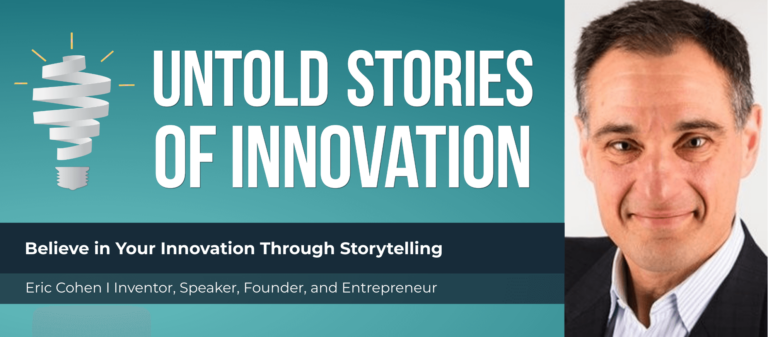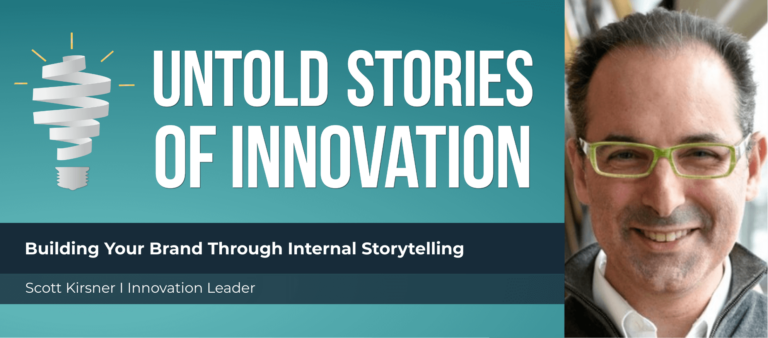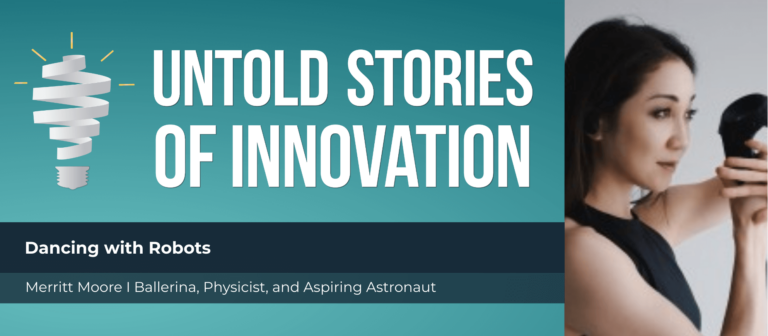Redefining Success in Innovation with Chris Denson
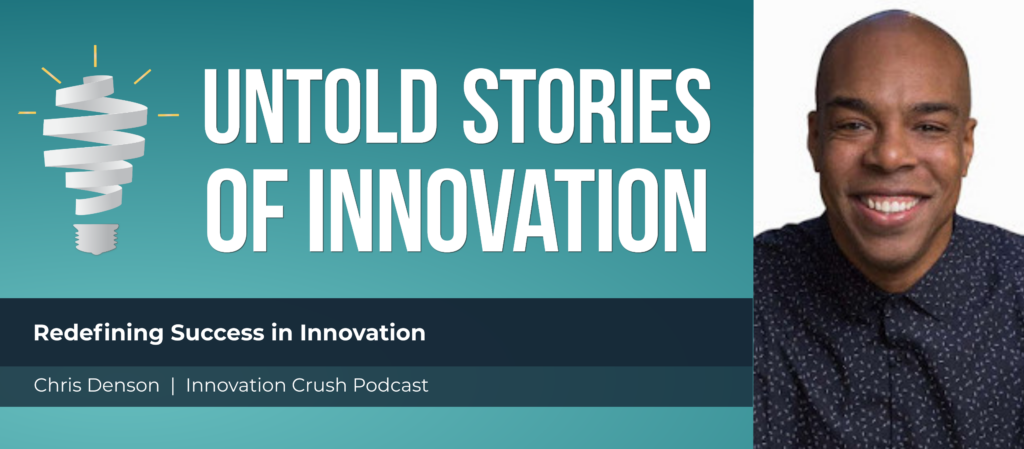
Untold Stories of Innovation
“Success doesn't always look like you envision it, but eventually the bits and pieces start to come together. And as long as you remain open, you can find yourself in an unexpected place that doesn't look like you thought it would.” —Chris Denson, creator and host of the Innovation Crush podcast
From today’s episode you’ll learn:
Why do stories matter to the innovation process? What values can be instilled in innovators who share stories? How do innovation leaders inspire creators to tell and share their success and failure stories?
We speak with Chris Denson, creator and host of the Innovation Crush podcast. Chris shares stories with equal parts humor and insight, leading us through his personal story of innovation and the common truths to which all innovators can relate. Through interviewing and collaborating with hundreds of innovators and succeeding as an innovator himself, Chris has uncovered the keys to innovation: fearless creativity and honest storytelling.
Listen to his Innovation Crush podcast: https://thecrush.co/innovation-crush-podcasts/
And especially the infamous 189-pitch episode mentioned in this podcast: https://thecrush.co/podcasts/drake-sutton-shearer-the-evolving-culture-of-cannabis/
Check out his most recent book, Crushing the Box: https://thecrush.co/crushing-box-book/
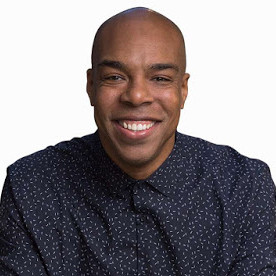
Chris Denson is an award-winning innovator, author, and host of the Innovation Crush podcast with over 750,000 subscribers around the world. Having been a guest speaker, curator, and attendee at hundreds of industry events, Chris is an expert at uncovering the best thinking and commonalities across a diverse array of cultures. Chris also serves as an advisory board member to various innovation groups including HubSpot and SXSW. Applying his expertise to the likes of the White House, Art Basel Miami, and Omnicom Media Group, his work has been featured in Adweek, Forbes, the New York Times, and Inc, to name a few. He is also the author of the Amazon #1 best-selling book "Crushing the Box: 10 Essential Rules for Breaking Essential Rules," a series of personal and professional examinations of what it takes to be an innovator.
untoldcontent.com/trainings/innovation-storytelling-training
TRANSCRIPT
This episode is powered by Untold Content’s innovation storytelling training. Increase buy in for your best ideas in this immersive and interactive, story-driven experience. Where your teams refine storytelling techniques for their latest projects, prototypes and pitches—and get inspired by 25 epic examples of impactful innovation stories. Learn more at https://untoldcontent.com/innovationstorytellingtraining-2/.
Katie: Welcome to Untold Stories of Innovation, where we amplify untold stories of insight, impact and innovation. Powered by Untold Content, I’m your host, Katie Trauth Taylor. Our guest today is Chris Denson. He is an award winning innovator and marketer and, of course, host of the Innovation Crush podcast. It has over 200 episodes, 700K subscribers around the world. And Chris is just a powerhouse thought leader when it comes to innovation process. Chris, thank you so much for being on the podcast.
Chris: Thank you. And thanks for such a lovely introduction.
Katie: Absolutely. Yes. I did not do it — I hardly scratched the surface. You have shared your expertise at the White House, at Google. Tell us a bit about your personal story of innovation.
Chris: You know, it’s interesting, I mean, that phrasing, “a personal story,” because it’s one of the things I’ve learned along the way. It is a very hyper personal thing when you’re creating in any aspect. I kind of cut my teeth in this space. I was actually working for the American Film Institute and the conservatory put in place by the government in the 60s. And for about 10 years, there was a digital content lab that operated kind of in the gallows of the conservatory. So we had like a hidden layer above the library. And our job was to be a think tank for marriage of the technology and entertainment. And at the time, we were like, oh, we should be at least 3 to 10 years out in the future. And, you know, the more the years went on, the narrower that gap got. And so just there we worked with everybody from PlayStation to HBO to the Leonardo DiCaprio Foundation to the Los Angeles County Museum of Arts and just kind of like experimented. You know, there were four of us who ran the lab, but at the same time, we would recruit volunteer mentors from all over the world. So at any given time, we’d have an extended family of about 50 to 60 pretty brilliant people who were doing stuff I did not know existed. So I think that was the first domino. And then it just kind of — that really struck a chord with me in terms of the spirit of invention. And, you know, it’s almost like when you get shown your superpower, you’re like, oh, that’s what I’ve been doing all this time. So you didn’t have — I didn’t really have the words or vocabulary to kind of express what I was interested in from a business and creativity standpoint. So that was the first and then just kind of kept going from there.
Katie: What inspired you to launch Innovation Crush six years ago?
Chris: Probably that same sort of mechanic. I think, you know, when you’re at the tip of the spear in any sort of way, you do a lot of talking with your hands because you like — whatever you’re talking about doesn’t exist yet. You’re like, and then it’s going to do this, and it’s going to do that.
Katie: Yes.
Chris: And so I left the company, I was working for a company called Machinima. And it’s — for anybody who’s listening who’s a gamer and nerd culture junkie — this was like a poster child for success on YouTube at one point in time. And I left there and I started talking to a lot of companies about the idea of innovation as a practice in their organization. And most of them did not know what I was talking about. So they were like, oh, so you’re a creative director. And you’re like, sometimes. Or, oh, you’re the technology guy. Sometimes it’s technology. And so it just kind of — I knew of a few people that I admired who were doing what I was talking about. And so I just kind of used the design of Innovation Crush to kind of build that community, tell those stories, reach a broader audience and show that this is an actual sort of operating mode versus, you know, some end product that magically appeared one day, which is typically — in some cases — how we look at innovation.
Katie: Yeah. Tell us about the twisty, turny, pivot-filled and sort of murky and failure-filled world that you’ve come to uncover through this podcast and all the work that you do in the innovation space.
Chris: Oh, it’s ugly. You know it’s funny, I remember the first time I was like, oh, this isn’t as pretty as it sounds. Even for somebody who had kind of like dipped their toe in the water. A really good friend of mine, she won’t mind me mentioning this, her name is Z Holly. And she wrote the charter for TEDx. At the time she was — let me see if I can get this right — the Founding Executive Director of the USC Annenberg Center for Innovation. So she was the first executive director there, built that lab and then also began to work with TED to create TEDx. So this was the first TEDx at USC. And just somebody like I admired from afar, I didn’t know her before we did the show. And the first thing she said was like, well, why do you want to talk to me? I was like, because you’re amazing. And then as we were talking, it was such a — I’m overexaggerating — but it was a little bit of a downbeat of an interview. Right. I’m thinking about you’ve done all these exciting things, and what you’ve come to find out and what I started to hear repeated over and over again was that, you know, the innovator’s journey is a lonely one. You know, if you see the world a certain way or you have a vision on how things can be done better or differently than what people are used to, you know, it’s going to take a while before everyone’s on board with that vision. You know, fast forward to whatever, a hundred and some episodes later, I interviewed another guy by the name of Drake Sutton-Schearer, who founded a company called PROHBTD, which was one of the first movers in the cannabis space. And probably within 10 minutes of our conversation he’s like, you know, we pitched our business 189 times before we saw one dime.
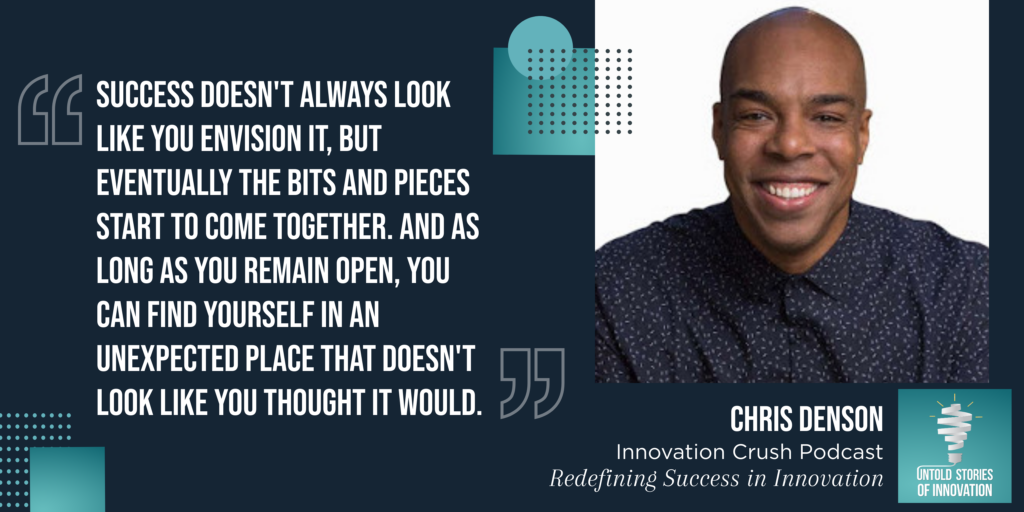
Katie: Wow.
Chris: And I was like 189 — it kind of blew my mind. Almost 200 pitches. Right. So the idea of keeping up enthusiasm against opposition to, you know, know where to pivot and reinvent, especially if, you know, let’s say you started a business and a year and a half later, is like you’re still not at a place you want to be and the world is changing, you’ve got to pivot again. And so you’re just kind of constantly in a state of iteration. And there’s emotional grit attached and there’s communication skills necessary to make sure that your vision is stated and presented clearly, all these different things. And, you know, even inside of organizations — I mean for awhile I ran the innovation practice at Omnicon Media Group and there are — out of 10,000 employees around the world — are about 20 of us focused on what’s around the corner in terms of culture and technology. And even inside of an organization doing well, and one of, you know, “Most Innovative Agency” award at Cannes Lions, like you’re always fighting for, you know, what looks to others to be new. And that could affect business, it affects, you know, how you’re able to get projects done, it affects budgets, it’s so many different things that go into what we look at as, oh, that was innovative. It’s just not as — it’s not always as sexy as —the process isn’t always as sexy as the outcome.
Katie: And I love the examples that you just shared because you shared with us a startup experience and also an enterprise experience and sort of being on this small but mighty team of innovators inside of a company with tens of thousands of employees. And, like you said, it can kind of be a lonely business when you’re in that position. Share with us some of the stories, if you don’t mind. I would love to know some of the experiences that you and your team had when you were trying to get buy-in or change culture or really help guide people to sort of look up from their annual roadmaps. What was that experience like? And especially if story played a role in it, what role did it play?
Chris: Oh, Katie, there’s so many. One sort of practical like project example, this was like I wanna say like 2014 maybe. We were working with Warner Brothers. And this is right around the time VR started to get a little bit more popular you know from a business standpoint. And they were releasing a movie called Into the Storm, which was like a tornado storm chaser kind of film. And we were like, oh, what if we created a VR experience where we could put people in the eye of a tornado? And so, first of all, we went back and forth on how much like, oh, tornadoes are serious and we don’t want to turn them into a game. Like so right there there’s already sort of a misunderstanding in what it is, that we don’t intend it to be a game, we intend it to be an experience of the film, et cetera, et cetera. And then we also decided not to just do VR, but also build a box where you’re basically taking on this 90 second experience where you’re thrust into a tornado and you’re hiding in a storm drain and things come crashing at you. But inside this box, we also built vibrating seats and fans. So both of those things would increase in intensity depending on where we were along in the experience.
Katie: Awesome.
Chris: And so we needed probably like a good three month runway to do that project. And so the client kept going back forth, back and forth, they were like, no, no thanks. And so we probably had a good six month lead at that point in time. Come to about six weeks before our marketing deadlines and it was like, hey, remember that tornado VR thing you guys talked about? Can we do that? And so not only did we have to do that, it was also like on a rush timeline. And we ended up winning a bunch of awards for that project. And at the time that we launched it at Comic-Con that year. There were only — there was only one other VR experience, which was the Game of Thrones like scaling the wall. Which is cool. But, you know, it’s like it’s limited. So by comparison, we had just had a lot more experience before that all over the world and so forth. But that idea of like kind of fighting for the vision and continually communicating it and then once you actually have an opportunity, it doesn’t even look like you hoped it would from a logistical standpoint. But aside from that, like we did not stick with the agency for a second, you know, a lot of it is just — if you’re an intrapreneur in any way and your job is to discover new opportunities. We had to determine a cadence by which we could just continually stay in the agency’s face, right. Our clients, the other teams, other groups around the world, et cetera, et cetera. So we developed other products and services. So we would write a book every quarter, which we called Pop. And it would just be like 50 interesting things we’ve seen in culture. Right. And we’d kind of present them on the phone, but we’d send the books to all our clients and things like that. We would do an annual trends report on culture and technology and kind of roadshow that. So any time we can just showcase our knowledge and expertise and educate people, it made the job of selling an actual idea a lot easier. So, you know, it’s a lot more work that goes around the actual building of the things.
Katie: Yeah, absolutely. I love that you shared those tensions in the beginning of trying to align everyone on a shared vision for what “done” could look like. And then some of the challenges of navigating that. And then also having to accept at the end that “done” hardly ever looks exactly like we expected it to in the beginning of an innovation process.
Chris: Oh, absolutely. Yeah. I mean it goes for every stage of it, right. You know, I’ve kind of adopted this principle that I’ve heard, it’s not my own, but “done is better than perfect.” And so a lot of times, whether that’s you’re in a pitch phase and you’re like, all right, all I’ve got right now is a paragraph. Like, well, maybe you can roadshow that with a few select individuals. Now I have a deck. Now I have an MVP. And none of that stuff ever feels like the full vision, you know. Even when you do get the thing made, it’s just like, oh, we want to do so much more. I like to compare that to other industries as well. You know, I wrote a book a couple of years ago, and I have a friend who’s a really great documentarian. And we were just talking about the process of creating stories. And we were like, you ask any documentary filmmakers like, oh, we had so much more we wanted the show, or so much more story we wanted to tell, or we ran out of time, we ran out of budget, and this is what we have. And it could be like the best movie you’ve seen. But you’re like — that creator had a whole other vision, you know, that they didn’t quite get to. And so how do you reconcile that internally, logistically, you know, and give up that real estate and get to a place of done is better than perfect. And it’s hard to navigate sometimes.
Katie: Yeah, absolutely. Especially — we didn’t get to touch on this too much, but you mentioned that at the very start of our conversation, the emotional turmoil of being an innovator can be so brutal to ride the ups and downs, the exciting times where people are — when something’s picking up steam, and then the really down times where you are going for pitch number 189 getting any buy-in. Which I think that’s probably the highest number I’ve heard. But I would love for listeners of the podcast to comment and tell us what’s the highest number of times they’ve had to pitch something before it got traction. Can you talk a little bit more about, you know, how you navigate the emotional ups and downs of innovation or how you see other people navigating that?
Chris: Yeah, you know, it’s not easy. I mean, for me personally, you know, sometimes you have good days and you have bad days, just like anything else. I personally try to do a little bit of comparative analysis, I guess. You know, if you think about the job that you’ve got and then, you know, it was your hundredth resumé that you sent out that landed you the dream job. Right. Or if it was — we get into these patterns of repetition. I was kind of birthed in the business as very subjective, I did standup comedy for about six, seven years. And so, you know, to be delivering your best material and look at an audience with blank stares on their face when just last night the audience was in a ruckus, right. Like you kind of experience this repeat, I’ll call it rejection, over and over and over again. And I think the more you experience that, right, the more you kind of develop a muscle to get through it. And, you know, so I think for, let’s call it a first time entrepreneur or a first time innovator, it’s like that feeling of rejection could be pretty overwhelming. And, you know, but the 10th time you experience, the 20th time. And as long as you’re experiencing some success along the way, you know, whether that may be that pitch didn’t get you the funding you wanted, but it got you a really great partner. Or maybe it didn’t get you a partner, it got you a really good resource. There’s all sorts of different outcomes. So I think it’s also recalibrating what success looks like. One of — our chief innovation officer when I was at the agency used to say the best compliment we can get when we leave a room is — the best comment we can get is I didn’t know that. Right. I didn’t know that was possible. And so the fact that you can — success actually in that regard is not the number of projects we do and that are out in the world. It’s how many people we give new information and inspiration to. And even in the case of that VR experience, we got turned down the first time, multiple times. So, you know, obviously, but we left enough of an impression that it circulated within those teams and it came back our way. So, you know, it just I think success doesn’t always look like you envision it. But eventually the bits and pieces start to come together. And as long as you remain open, you can find yourself in an unexpected place that, again, it doesn’t look like you thought it would.
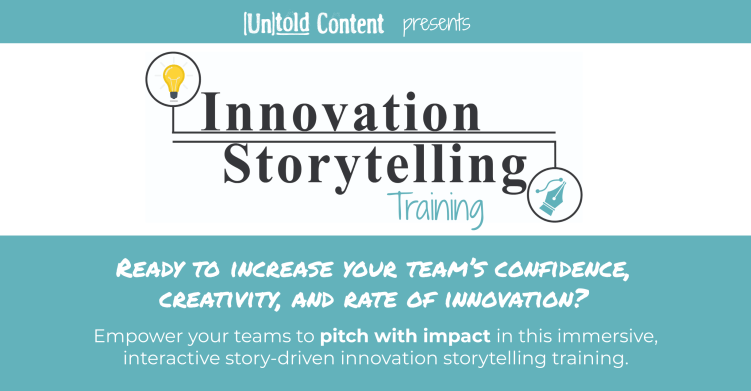
Katie: That’s really strong advice. I’m wondering, could you break down, in your opinion, what kinds of failures or what kinds of losses are good and productive and which ones are to be avoided?
Chris: Yeah, I guess if I understand your question correctly, I’d say — you know I talk about this topic of microfailure. Right. And you can listen to any podcast or watch any TED talk and people talk about like, oh such and such died or we lost 10 million dollars or I put my family’s house up and we lost the house. But I think about those things are like those 20 emails you sent out and nobody responded. Or the call that keeps getting rescheduled, and now it’s eight months later. Or the person that says, oh, we love it and I’m going to talk my team, this is the kind of stuff my boss loves and we just greenlit something like this, so it’s perfect. And then that doesn’t come to fruition. There’s all these sort of like smaller things that I feel eat away at your creativity and your enthusiasm and your energy around whatever it is you’re building. So when I think about failure — and not necessarily to avoid or overcome but just like to be mindful of those small — in the book I call that chapter Death by a Thousand Slaps.
Katie: Yes.
Chris: Like one slap, OK, you got me that hurts. Three, you’re like, OK, that’s enough. And then a few hundred later you’re like, you could be at the hospital. So it’s that sort of — I think those are things to watch out for. Right. And on the flipside, I think — I learned this recently in a conversation with the inventor of Pictionary — and he said as he was building out that product, he was like he started to plan for success. You know, most of us know what we’ll do if we fail. Right. We’ll go back to the job or, you know, I’m going to give this, you know, a year and if it doesn’t work, I’m going to go and do XYZ. But we don’t plan for like, oh, it really works. What are the possibilities? Right. Like really allow ourselves to imagine, you know, deeply. So I think failure, it looks so many — it looks so different just depending on who you are, what you’re making, who your teams are, what’s the time of year, like so many different factors and things that can kind of mess up along the way. You kind of don’t know. You don’t know what the failure is going to actually be. You can kind of get ahead of it and be predictive. But for the most part, it’s kind of like remaining an openness to whatever happens.
Katie: I love that you’re talking about the importance of envisioning what success could look like as well. Did you know when you started your podcast or when you started to grow in the innovation space and become an author and a speaker, did you know what success would look like for you? Could you have envisioned where things are now in your life?
Chris: Oh, no. I mean, I think I think about things, but my personal mechanic sometimes is to like, just try to stay in the moment as much as possible, you know. Even since I was like interviewing as a college student when they were like, oh, what do you plan on being in five years? Like, I don’t know. I just want to want to do good work and see where it takes me. Right. Like I don’t know per say, I don’t have — it’s not like I went to school to be a doctor, and I know at the end of medical school I want to work at a trauma unit. Right. It was more so like, you know, let me — let’s see. Let’s try to be open. And almost to a fault to some degree. I mean, you asked about Innovation Crush. It was like, OK, cool, let’s start a show. Like I was working with this network called Sideshow at the time and they had a lot of comedy podcasts. And like I said, I have a background in comedy, but I also have the business sense to make Innovation Crush a cross between Fast Company and The Daily Show.
Katie: Yes, I love that.
Chris: But I didn’t — like even when I started working, I was like, oh shit. It was kind of an oh, shit moment. Like, oh, now what do I do? And so, you know, I think you start to not necessarily chase after the success, but it’s like what do I do with it now. I didn’t build any social media assets, I didn’t — and also, you know, if you’re a one man show or a small team, it’s like there’s only so much you can do anyway. So, I had visions of things I wanted to do. I didn’t know what success looks like, but I knew, like, the grand vision was like, oh, cool, like, what if there was an A.I. tool that when, you know, you went onto the website and you type in like a thing you wanted to know about and it served you up the three or four, ten, whatever, podcasts that mentioned that. Or with my book I wanted to do like augmented reality. So being able to like scan a chapter title or an image and it takes you to another experience. And there’s things and like visions that I want to do that sometimes I just don’t have the budget or resources or time to do. So I think that’s where I kind of see my own hurdles on a day-to-day basis.
Katie: And yet those kinds of restraints, or constraints are exactly the thing that can kind of open up a lot of opportunity to innovate.
Chris: Oh, absolutely. I’m a firm believer, like some of the best, you know, innovation comes from constraint. Even going back to the agency, it’s like if you have a client that spends hundreds of millions of dollars a year in media, billboards, print ads, digital media, and you’re like, hey, what about this robot? What about a customer service robot that could also deliver messages and coupons and you know and know everything about your product and your service and your customer. And they’re like, that’s cute, and you kind of get the pat on the head and then like, here’s 20 dollars, go. Like, let’s see what you come up with. So you’re always up against some form of opposition or constraint. And, you know, like even in the case of the things I wanted to do with the book, I was like, all right, well, what can I do? And this stuff is not the most, quote unquote innovative thing, but ended up doing a mixtape. Which was I worked with a friend of mine who’s a deejay, a guy by the name of Mick, a deejay and an investor, and so many other things. He’s been a guest on the show a couple of times. And like I ended up circling back for people that I had anecdotes about in the stories. I was like, hey, what’s your favorite artist or album? And they all sent in different answers and we used sound bites from their interviews and mixed them in with songs from that library that we had collected.
Katie: Yes.
Chris: So, again, it wasn’t like a huge technological feat, but it was just like, all right, well, what can I do that’s different than what I’ve seen out in the world? And so a podcast or to promote a book using a mix tape which also uses the podcast, is like a fun sort of like, oh, this is interesting. And it didn’t cost me anything. It was a mutual, like, mutually beneficial partnership. So just figuring out what you do have. A lot of times we’ll look at sort of a goal of some sort, a product goal that we’re looking so far down the road like, oh, if we only had X, Y and Z. But sometimes you look at that circle that’s around you and there’s so many tools and resources you already have that you may overlook pretty easily.
Katie: That’s incredible advice. Can you share with us — my goodness, you have interviewed hundreds of innovation leaders or just inspiring people. Could you share with us some of your favorite stories that they’ve shared in their sort of innovation journeys?
Chris: Let’s see. My one go-to, and I just really like this — there’s two. The first is a guy by the name of Dan Goods, who’s NASA’s visual strategist. He works at JPL, he — by layman’s terms, he’s the artist in residence. He’s been there for 17 years plus helping craft missions, turning NASA science into public art experiences. And just kind of, you know, in the middle of our conversation, like — you know, you’re a marketer, right, at the end of the day so people can experience what NASA is like from a, you know, something that they can relate to. And he also tells this story about a project that he had done and he had to draw a picture of an otter. And then somebody was like, come down to the pool. And they showed him a video of an otter swimming. And they were like, get in the water and swim like one. And so he redid the assignment, right. He got in the water, he mimicked what he saw in the video. And it really got me thinking about this idea of empathy. And so I actually open up the book with this idea. It’s called Swimming Like an Otter. And you know when we’re creating and developing ideas and products and services and what have you, it’s like, how far are we willing to go to be in the shoes of that end user, customer, recipient, benefactor or whatever. And so I tell, you know, tell this story through other lenses as far as empathy and how you develop that within your team and the products you make, et cetera, et cetera. The other one that kind of gets me — it’s probably because I’m a parent and family and all this stuff — is Nolan Bushnell and Brent Bushnell. So for those who may not know, Nolan created Atari and Chuck E. Cheese and probably 25 other businesses you’ve interacted with. He was the only person to ever fire Steve Jobs. And Brent — he has I think five or six kids and they actually do a Bushnell family panel at South by Southwest every couple years because they’ve all been, like, super successful in their own right and along the same lines. And it’s kind of like, how do you pass down the generational knowledge or behavior, you know, whether that you need to pass that down to younger people on your teams or you need to you know, you want to pass down to your own family members or you know, or leave a blueprint behind, you leave a company. And this is like, all right, here is all the principles and things we’ve learned about how to make this like awesome. Steve Jobs, you know, passes away, Apple still makes amazing products. Right. So it’s all rooted in some sort of blueprint that came from a few select individuals. But then last but not least, you know, I think as much as we put a lot of individuals on pedestals, you know, I’d like to ask a lot of questions about teams. Like Sugar Ray Leonard is a great example. And we’re like, oh, you’re the champ, you won the Olympics, you know, also titles and belts and things. Like usually we celebrate the champ as a singular person. And he goes, oh, yeah, he’s like, I had trainers waking me up at five o’clock in the morning who’d literally, like, come and drag me out of the bed. He’s like, I love McDonald’s, he’s like, he recalled like two or three times, you know, someone pulled McDonald’s out of his hands and threw it in the trash. So it’s just like the types of people around these — like Elon Musk, for instance, you know, he’s got a whole team of people. He has to be the face and of course he’s a brilliant mind, I’m not arguing that. But, you know, also the people that are around these individuals are equally as important. And I think those are, you know — to humanize the innovation story means that, you know, we kind of like demystify what we know about these folks.
Katie: Exactly. It gets back to your earlier advice about looking around your current community, the current people in your network and thinking what’s possible if we were to put, you know, X and M and P and Q together here, and how can we become connectors and really lean into the places where we already are embedded. And what gaps are there, so where should we go and discover more and make new relationships and form new partnerships. I love that advice of, you know, seeing that innovation is a team sport. Yes, there are garage gurus.
Chris: That’s true.
Katie: Yeah, you know, we’re always going to want those inspiring leaders and we’re always going to be fascinated by that. I think especially as Americans, it’s sort of part of our cultural identity to hold the individual up in the spotlight. But it is, it’s really a team sport. And without that — I love that vision of sort of looking around at who’s supporting who here and what’s possible, really, none of this is possible alone.
Chris: Oh, absolutely not. You know, it’s easy to create in a vacuum, you know, and I think once — like I believe in the power of planned serendipity. You know, getting the right people in the room just to have a conversation at the very least. We did this project last year at South by Southwest called GovCity, which — pat myself on the back — just won a Fast Company “World Changing Idea” award a couple weeks ago.
Katie: Yes, congrats.
Chris: But, you know, we didn’t overplan it, right. We knew if we curated the right minded people in the room — so one example is a friend of mine runs innovation for the U.S. Census Bureau. So it’s a census year this year and it’s the first year that it’s going digital, and they have all sorts of cultural partnerships and all sorts of things. She was like, oh, can my boss come and speak. And I was like, no. Because — and not because he’s not awesome and accomplished — but there was a specific mindset I was looking to curate in the room, like for people that are curious and, you know, a little bit of polymath, a little bit introverted, but also super brilliant. And, you know, I think you put enough of those people in the same space, you know, and this was a 48 hour think tank that we put together. And, you know, we knew that there would be some great outcomes. I think even by the middle of day two, there was a group like, hey, guys, we’re making a video game. Mind you this is like NASA, Air Force, the LA mayor’s office, like people you wouldn’t say were like, oh, we’re going to invent a video game with anybody wants to join us, you know, come on, let’s do it. So, you know, a thing is, yes, those resources that are around you, but making sure you’re curating the right mindset of individual and also just like allowing a little bit of wiggle room for ambiguity. And so, yeah, and that part to me is the most fun. It’s like that discovering like, oh, who knew that these two — like you said just a second ago — putting these two things together would make something incredible. And that’s the fun part.
Katie: In those moments where you’re pulling together, you know, people who you think will have strong synergy and you’re trying to set them up against an innovation challenge of some sort, what role do you see story playing? Whether that’s in the formation of teams or in the way that they pitch their prototypes at the end of the challenge. What do you think, where do you hear story living within those moments?
Chris: You know, before — and rightfully so — but before the world got a little sensitive to the phrase “me too.” I used to call these the “me too” moments. You said, you know, at some point, you know, if you and I were not recording a podcast, were having a normal conversation — which we are to some extent — like there would be something that you say that I’m like, oh, yeah, I’ve experienced that, too.
Katie: Yeah.
Chris: So you start to develop this connective tissue and then you do that multiple times over and over again. So even in the case of GovCity, one of the things we wanted to do was create a safe space. Right. So we didn’t record anything, there were no video cameras, et cetera, et cetera, because we wanted people to have honest dialogue about where the hurdles are. Right. And, you know, a lot of times you go to an event or you’re asked to speak on the stage or something like that and it’s like, here’s our wins, you know, I’m the opening keynote and here’s all the successful things I’ve done, et cetera, et cetera. But to go, you know, we do well at this and here’s the three areas that we struggle and here’s why and here’s, you know, what’s really hard for me personally. And somebody else in the room goes, I’ve experienced that, too. And it could be an arts organization talking to a finance organization, you know, talking to a military organization. And then, you know, you start to borrow and steal certain principles of getting through hard times from other industries and vertical. So I think by people sharing these honest stories, it gives other people permission, if not, you know, or collaborative lens to look through to work on that also. And so I think storytelling plays a huge role in that part of it. The other part we — like on the tail end of that, yes, that’s the discovery piece, but then you get into the actual pitching. And, you know, that’s an art in and of itself. Right. I think any idea is only as good as it is communicated. Right.
Katie: Yes, yeah.
Chris: So you could have the best thing in the world and if you can’t figure out how to distill it down into, you know, five pages or one short blurb or whatever, it might be that someone goes, oh, OK. And that’s why we say like, oh, it’s like Uber for tacos. Because people go like, OK, I get those two things.
Katie: I would — I want to invest in that company.
Chris: Yeah. Can we edit that part out so I can go start this and get it funded.
Katie: Yeah, exactly. No one else can take this idea. This is ours now, Chris, me and you.
Chris: See, who knew you’d make a million dollars today. So, yeah it’s the reason we make those sorts of associations. You know, anybody who’s worked in entertainment, you know, it’s always like, it’s like this show, but different. Right. Or it’s a character like this you’ve seen. So we try to make things familiar to people so that — because we’re doing something new-ish.
Katie: Absolutely, yeah. You have to ground it, it has to be relatable. I love this idea, too, that the failures and the sort of the scars on us or the things that have been our biggest challenges, they’re actually another opportunity to relate. So that importance of relatability. It doesn’t just apply, like you said, to products. It applies to the person and the founders and the people spearheading, you know, a team. And if we can’t — really what you’re saying is credibility is built not by bragging. Right. This is maybe a simple wisdom, but I think a lot of people miss the opportunity to relate by showing that they deeply understand what the challenges they’re going to face are or have been, and they’re willing to own that. And it creates this much deeper opportunity to connect with others. And it builds authenticity and it also builds trust. People believe if that leader is willing to admit the challenges that they’re facing, then that person is going to be open to learn and to grow so much faster. And any kind of innovator is — whether they’re hitting full-on success in the beginning or stumbling their way towards the finish line, at some point you’re going to come up against a challenge. At some point, even if you’re the most successful person in the entire world, you’re going to eventually come up against those challenges. And so it’s really part of, I think, a respect and a trust that can grow when we present ourselves as informed and hungry-to-learn admitters of what the challenges are.
Chris: Yeah, I mean, great point. I think, you know, you just reminded me of a video I watched a few times, actually, but I just sent it to a group I did a story on and works out for. But it’s a video of Ray Dalio meeting with P. Diddy, and Sean asking him like all sorts of brutally honest questions about himself. He’s like, you know, he’s like, I had to leave the game for a minute. I didn’t think people on my team were performing to my level, how do I get around that? Like, he was just he’s like, management styles and hiring and all these things that he felt like he was in his own way about, or at least in his head about. And so, you know, again, that idea of like, here’s somebody that we like, oh, he’s made The Rock and Sean Don and Bad Boy, gave us like all these great hits and everything else. And here he is kind of presenting his most vulnerable self. And I think for me personally, like that was one of the most valuable pieces of content that I’ve come across with his face on it. Right. Like, of course, I love the pop culture moments, could be getting scared on Ellen or whatever. But there’s a celebrity and then there’s a human being. And so I think those are the things — and even, you know, on a more practical standpoint, I had recently interviewed a guy who’s the chief storytelling officer for the city of Detroit. Which is where I’m from, hometown love.
Katie: Yes.
Chris: And he, you know, I think he’s only the fourth person ever in the country to have that title like officially, you know, like part of the civic job. And he was like, for a while — he has his own marketing agency — and he was going through some financial hard times personally. And so he was like he was telling those stories on LinkedIn. And his business partner was like, are you sure you should be doing that? And he was like, he said, somebody needs to hear this, right. We’re building a business and I’m like, my lights are cut off. Right. Like because that story is much more common than the Elon Musk story. Right. And so he’s finding a way and he’s documenting it in real time. That’s a little extreme. But it’s that willingness to be like, here’s where, you know, I’m struggling. And I think culturally, we have this lens of transparency thanks to social media and thanks to Google, being able search and look up anything about any company or any person, you know, whether it’s a criminal record or it’s a huge success. And so sometimes there’s a disconnect between what an audience might expect from a person or a brand versus what we feel comfortable giving them. So, you know, it’s a tough gap to close. But, you know, I think just attempting a thing or two here could just be, you know, it’s important to experiment and trying different things to see what works.
Katie: Yeah, absolutely. And vulnerability, I feel, is one of the hardest things to do in a business context, where I feel like from a young age we’re trained to sort of cover things up and only present, you know, the perfect shiny PowerPoint or whatever it is in our early training. And I would love to see more young people be able to, you know, be encouraged to share why something didn’t work and to talk through failures. Young professionals, too. To get that experience and really start to get comfortable with that. Because it’s very uncomfortable for a lot of people to talk through why something might not work.
Chris: Yeah. You know, a lot of us like to tell the other side of the story. It’s like, I went through this — and there’s another quote, which is, sometimes God puts you through something just so you can tell someone else how you got through it. And so they’re like, oh, that happened to me, too. Like, it’s kind of post, right. Which is still valuable. But the more vulnerable part is like, this is what I’m dealing with now. Right. And you may have a mentor or person you can talk to about those things. And so — but the other side of that, too, you know, when I think about microfailures or the difficulties we’re facing in the creative process — emotionally or business-wise — I think we also have to remind ourselves of our successes. You know, and that’s the thing that we forget to — like I got some bad feedback on a presentation I gave like a couple of weeks ago. And, you know, some of it I felt like I 100 percent agreed with and some of it I was like, OK, have I done this before and did it work? Right.
Katie: Right.
Chris: It’s that comedian’s journey where you like, you might kill three nights in a row with the same material. That fourth night, for whatever reason, it just does not click right.
Katie:Right. And it doesn’t mean to throw it in the trash necessarily.
Chris: Exactly. And so, you know, I think the other harder part of any innovator journey is, you know, what do you do with feedback? Right. And I don’t think there’s a magic bullet to it. I’ve asked almost everybody I’ve interviewed and also reconciled with myself like, I like that piece of what they said but I don’t like this piece. And just kind of move forward as comfortable as possible, despite whatever decisions you make.
Katie: I wish we could go back to your friend who had pitched 189 times and we could ask, how much did that pitch change from pitch one to pitch one eighty nine. That would be an incredible research question to ask.
Chris: Well, we did talk about that. So you guys can go and listen.
Katie: Oh, yeah. We’ll link to that episode. I’m so sorry. Yeah, we’ll link to it.
Chris: No, that’s fine. I actually can’t recall what they did. I think it was almost exactly what I just said. Just like sometimes yes, sometimes no. I might have been more — and I’d have to go back and listen to it — but I might have leaned more into like, how did you maintain enthusiasm, you know, from the third time to the 150th time. Same energy, same flow, another plane, another lunch, you know, another Uber ride. And you’re like, OK, here we go again.
Katie: Yes. Yes. Well, I will link that full episode of the Innovation Crush podcast in our show notes too so you can listen to everything. You have to check out Innovation Crush, if you have not yet for some crazy reason. And Chris, would you like to leave us with any more advice, especially about storytelling inside the innovation process?
Chris: Storytelling, you know — it’s very odd that you have to question in this time — but I think about the balance of making the story personal and also making it broad enough. So I think about this idea of mass customization, you know, where you feel like you’re talking to each individual. I think about like the idea of finding those points that connect. Sometimes we think about, oh, I tell a personal story, how will that resonate. But personalization doesn’t have to be like, oh, you know, I got beat up seven times so that’s why I started this anti-bullying app. It could just be some other data point that connects you with another person in the room. It could be like a band you like and maybe that band’s somehow involved in the program. Just some — these other points of connecting so that you can personalize it for the audience. Of course, it’s going to be personal to you. You’ve obviously got your blood, sweat and tears into it. And you have to remember that whomever you’re delivering that story to, they’re going to say that they’ve heard this a few times before. You know, whether it’s 5 or 100, like, oh, we get this pitch all the time. Or oh, I have a friend that started a similar thing or whatever. So, you know, thinking about what your points of differentiation are. It’s a whole like world of story. But I do think about like, how do you personalize it and connect and not just hit people with data and geek speak.
Katie: Yes. Yeah, exactly. And so that could be a personal story or it could be trying to paint an image in someone’s mind of what the future looks like. It could look like someone else’s words or voice, say, or a collection of voices. I think there’s so much creativity that can get lent, you know, to this space. And we’ll also link your book because that is one of my favorite creative pieces around innovation. And so we’ll definitely link it. And you have to check out Innovation Crush and follow everything that Chris Denson is doing. You’re amazing.
Chris: Not everything, you don’t want to see everything. Some of that stuff is personal.
Katie: I’m so, so grateful that you made time to talk with me today, and I am really excited to continue following all of your work.
Chris: Thank you. Thank you so much, Katie. This was great.
Katie: Alright. Talk to you soon, Chris.
Chris: Thank you.
Katie: Thanks for listening to this week’s episode. Be sure to follow us on social media and add your voice to the conversation. You can find us at Untold Content.
You can listen to more episodes of Untold Stories of Innovation Podcast.
*Interviews are not endorsements of individuals or businesses.
